Here is a list of Bosnian foods you can’t miss when visiting Bosnia and Herzegovina. Deciding which food in Bosnia to try is made easy with this tasty guide.
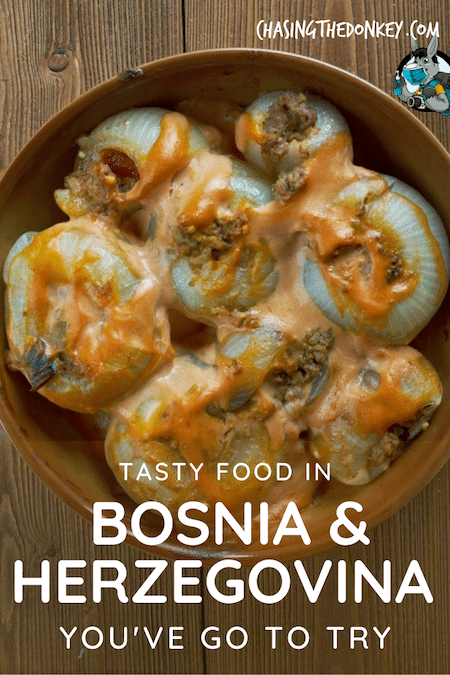
Artfully combining ancient flavors inherited from the Ottoman Empire, traditional dishes from Mediterranean Cuisine, and Central European tastes, Bosnian gastronomy boasts some of the most interesting recipes in Eastern Europe.
Are you ready? Prijatno! … Or Bon appétit! This article includes the most delicious dishes from Bosnian Cuisine, including snacks and a few interesting drinks you should try when you visit.
Skip Ahead To My Advice Here!
Bosnian Snacks & Appetizer Dishes
1. Suho Meso
Suho Meso is a dry meat cured in salt and left to rest for a long time over an oak-style fire. It’s a popular dry meat used in meze and special celebrations. Most people prepare suho meso in the wintertime and then use it a few weeks later.
Bosnian Meat & Fish Dishes
2. Cevapi, National Dish Of Bosnia
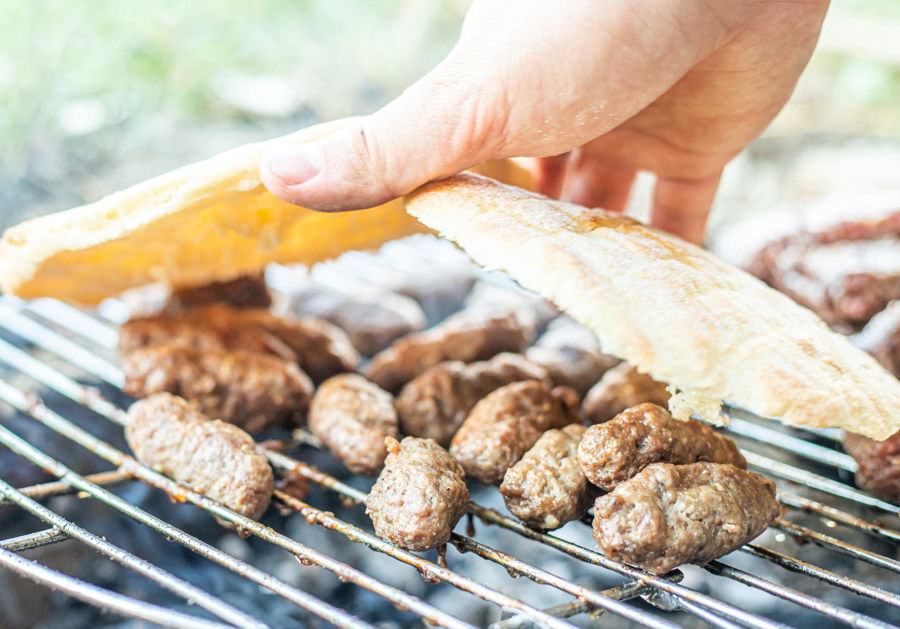
Rightfully occupying the first spot on this list, cevapi is the most famous dish in the country, and all over the Balkans, it is popular on any occasion, and, of course, Bosnians have their way of preparing it.
Cevapi is similar to an open sausage or patty made from minced meat, either mutton, veal, or beef, that has been kept in veal or mutton broth before being grilled and served in what is known as Bosnian kebab.
The dish is easy to find everywhere in the country, including in restaurants and fast-food eateries.
A portion of cevapi is served with flatbread (somun, the Bosnian pita bread) and a side portion of raw onions and sour cream, another staple ingredient in Eastern European cuisine.
3. Bosanski Lonac
You’ll see Bonsanski Lonac everywhere, and it’s a type of stew made with very tender meat and potatoes. It’s incredibly hearty and very warm during the winter months.
It’s cooked very slowly (usually more than five hours) over a super-low heat, which makes the meat literally melt in your mouth, and you’ll usually see it served with vegetables inside, too, depending upon what is in season, along with potatoes and garlic.
4. Bosnian Pot

Another super delicious dish that all Bosnians love and enjoy is bosanski lonac or Bosnian Pot—also considered a national dish in the country, this meat and vegetable stew is made with beef and seasonal veggies, such as potatoes, tomatoes, carrots, cauliflower, and peppers.
Bosanski lonac is a kind of stew unique to the country that is prepared following a special tradition.
According to the original recipe, the pot is prepared in alternating layers of large pieces of meat and vegetables in a pot until it is full. The dish cooks for over 6 hours, when it becomes a mouthwatering stew, with super tender meat soaked in a juicy sauce and highly flavorful.
5. Ćufte
If you like meatballs, you’ll love this dish. It consists of juicy meatballs served in a thick tomato sauce. It’s an old Ottoman dish that has been embraced in Bosnia over the centuries.
The meatballs include a mix of ground meat, herbs, and onions, but the sauce is what really makes this dish stand out. This isn’t your regular, watery tomato sauce but a thick, gravy-like sauce that you’ll probably want to mop up with fresh bread at the end.
6. Klepe

These small dumplings, usually steamed or boiled, filled with a mixture of ground beef (or mutton) and blonde onions sauté in a pan, is a delicious dish in Balkan cuisine; in some places, it is also possible to find them made with a cheese filling.
They are very similar to Turkish manti or Italian ravioli and are simply one of the best meals you can have in the country.
On top, you will not find tomato sauce but a delicious and creamy sauce made with yogurt and plenty of garlic.
7. Begova Corba
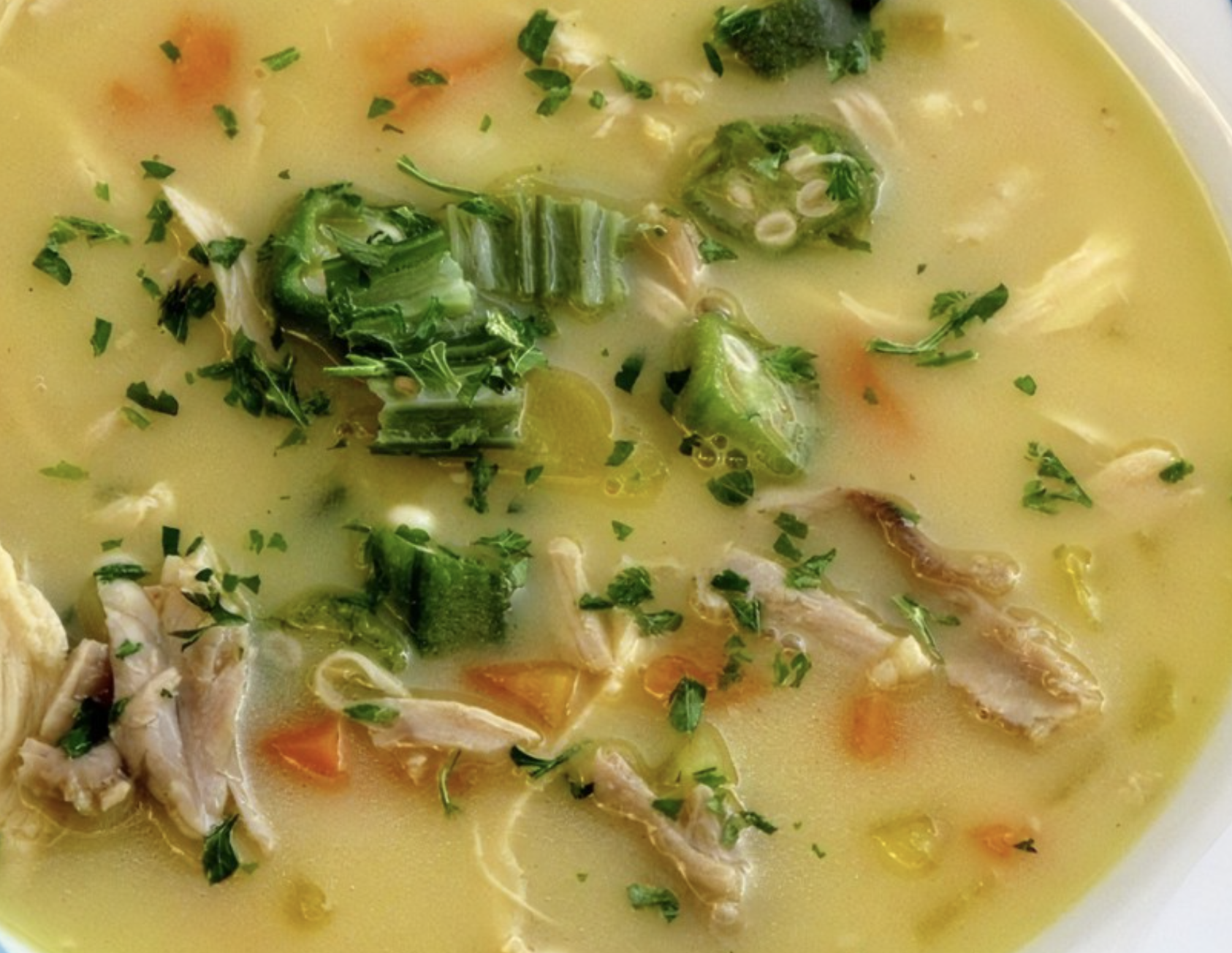
Slow cooking is a common tradition in Bosnian cuisine, like stews and soups. And this is the main secrete for a delicious begova corba, perfect comfort food for cold winter nights and during the holidays. This dish combines a bit of everything.
Begova corba is a chicken soup with plenty of vegetables, including celery, potatoes, carrots, and okra. It is often served with sour cream or fresh herbs such as spring onions.
The dish often boils in a clay pot for hours, resulting in a delicious creamy stew. This meal, also known as Bey’s soup or stew, is considered special in Bosnia and is a favorite thing to eat during important celebrations.
8. Pljeskavica
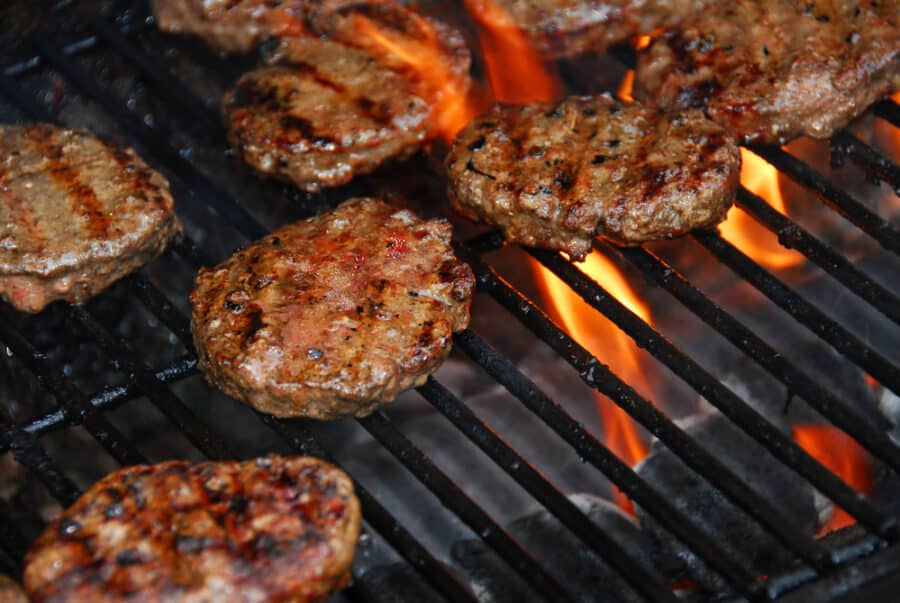
This typically Serbian dish considered a national food in that country, has crossed borders and has become a favorite in Bosnia as well.
This type of patty is made with a mixture of ground pork, beef, lamb, and plenty of hot spices.
They are often served inside flat pita bread, heated before being cut, and some onions and relish. A side portion of cheese salad comes with the dish to ease the spiciness of the patty.
9. Bosnian Grill: Rostilj
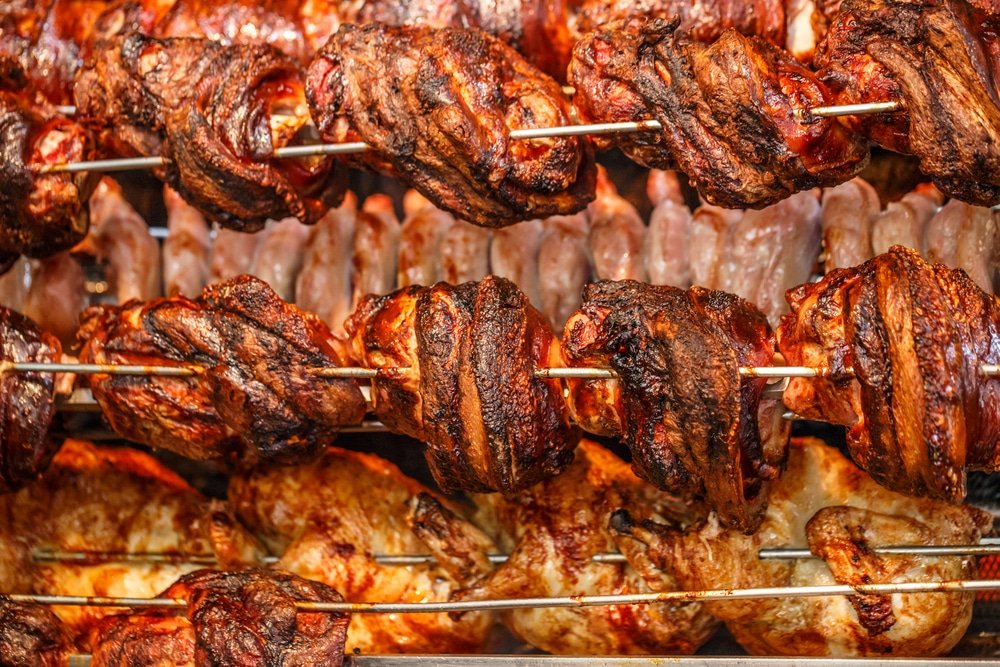
Usually, lamb, beef, veal, and mutton (in some places also pork is used), the most delicious meat dish you will be able to find is rostilj, a mixed grill platter featuring sausages (typically beef sausages or sudzuk), cevapi, steak and also chicken on occasions.
The grill comes with a vegetable side dish of your choice, such as salad or baked potatoes. French fries and slaw are also alternatives. If you are not interested in the full grill version, Roasted Lamb is a good meat alternative and can even be bought as street food in Bosnian towns.
Brands We Use And Trust
Bosnian Dolma And Other Stuffed Vegetable Dishes
10. Dolma & Stuffed Peppers
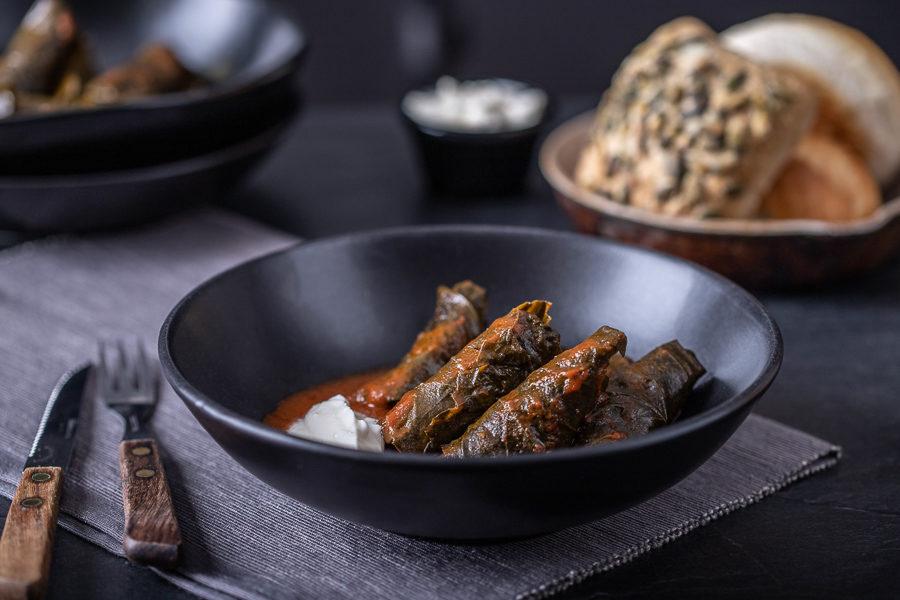
Stuffed vegetables are also found in the rest of the Balkan countries, Greece, Cyprus, and the rest of the Mediterranean. Stuffed vegetables are another fantastic dish you should try when traveling to Bosnia.
Dolma, the general name usually used to mention all the varieties of stuffed vegetables, is hugely popular and can be very different from each other.
You can try stuffed bell peppers (punjena paprika), as well as sarma, rolls made with pickled cabbage leaves stuffed with meat and rice. So, as you see, dolma is not just about stuffed vine leaves. Zucchini and eggplants are also used to make stuffed vegetables.
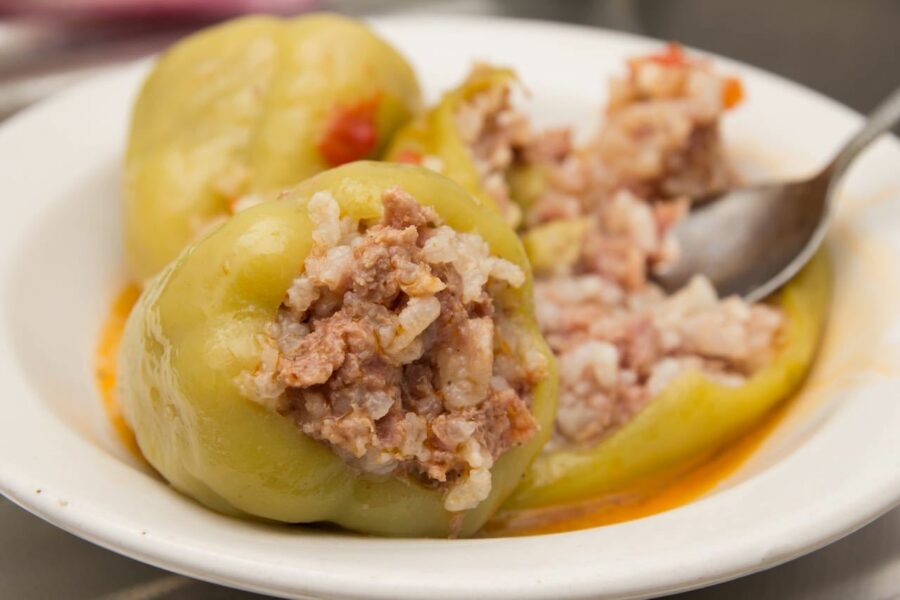
And in Mostar, there is a special type of dolma, sogan dolma, described next as an entirely different flavor and a fantastic dish of Bosnia and Herzegovina.
You can find peppers, zucchini, cabbage, and eggplants among the veggies often used to make Bosnian dolma. Seasoning is abundant, giving the dish a unique flavor. The filling can be a mix of rice and meat, although the most traditional one includes only white rice with herbs and spices.
On most occasions, meat-filled dolma is served warm with a lemon sauce. Traditional rice dolma often comes with a yogurt-based sauce and plenty of garlic.
11. Mostar’s Sogan Dolma

This unique dolma variety is a typical dish from the Mostar area. It uses onions as the main ingredient. In the original recipe, onions are stuffed with either meat, rice, or a mixture of both, and it is far from being a dry or tasteless dish.
It can be served as a snack or starter, and it is easy to find in any restaurant or eatery in the region. In contrast with warm regular dolma, sogan dolma will usually come to your table boiling.
Bread From Bosnia and Herzegovina
12. Lepinja

Lepinja is a type of bread that you’ll find everywhere across the Balkans, especially in Bosnia. It’s a flatbread that is usually served with most meals, and it’s what you will see when you have cevapi.
When you first look at it, you might think it’s the same as pita, but it’s a bit thicker and probably more akin to a light focaccia bread. It’s also creamy, thanks to the milk used in its creation.
13. Somun, The Local Pita Bread From Bosnia
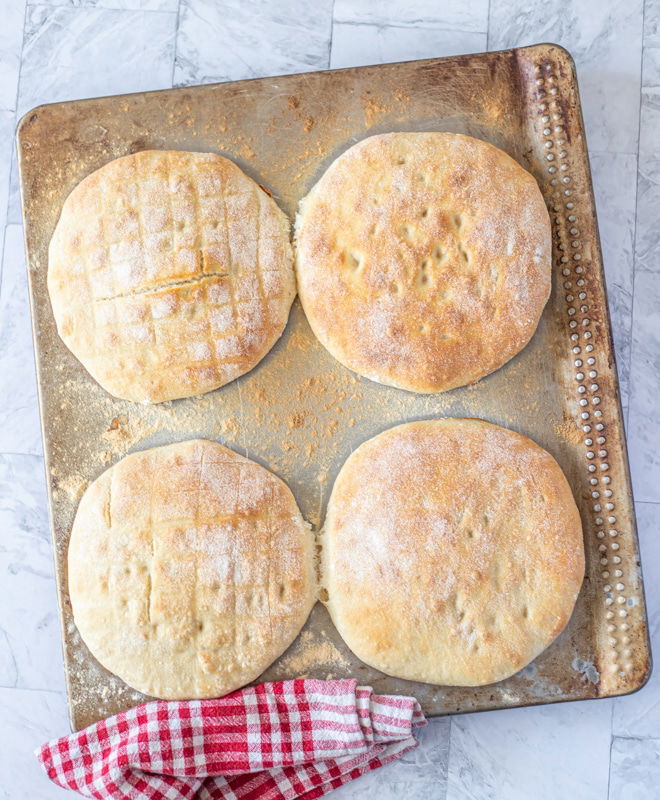
Available with any meal, commonly used to prepare snacks and sandwiches, and ideal to accompany the several meat dishes in Bosnian cuisine, somun is a type of flatbread, very similar to Arabic or Greek pita bread.
The most common way to find somun is with cevapi and other ingredients such as chopped white onions, a red pepper paste (ajvar), and soft cream cheese known as kaymak—a very traditional Bosnian food combo.
The bread is soft, chewy, and fragrant, with Turkish roots. The Ottoman Empire ruled the country for five centuries, permeating the Bosnian cuisine with hundreds of Middle Eastern flavors.
14. Proha
Proha is another type of bread, but this time, it is a cornbread that has a long history. Proha can be eaten on its own, particularly the newer recipe, which is spongier than the old-fashioned version, but it’s usually served with salad, Bosnian soups, and stew-type dishes. You might also see it stuffed with various things, such as cheese or spinach.
Traditional Bosnian Pie & Casserole Dishes
15. Burek
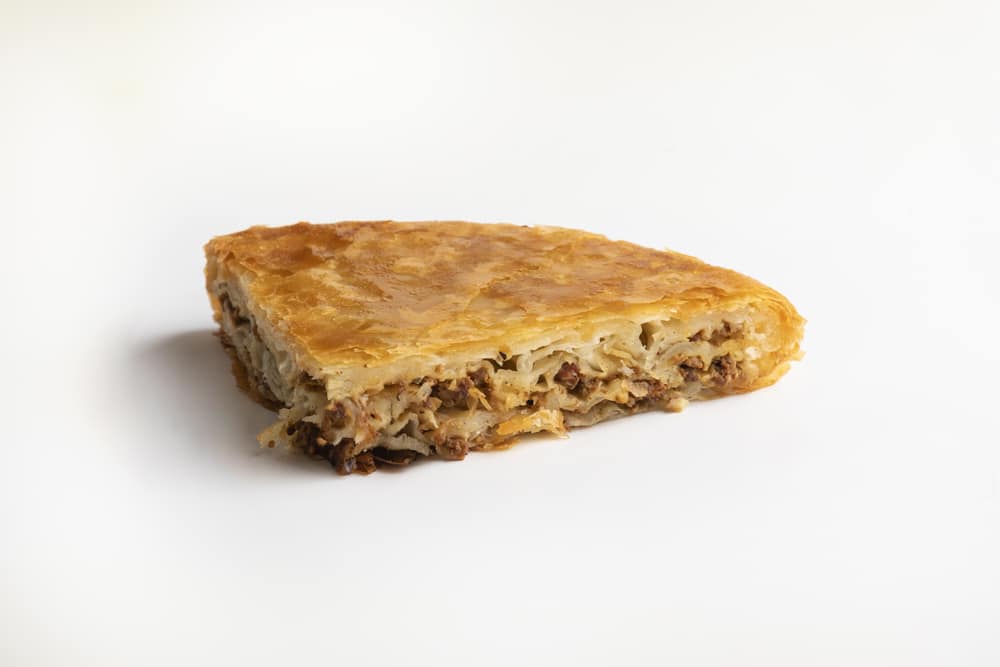
Also known as borek, this unique snack was introduced to the Balkans hundreds of years ago by the Turkish, who originally brought it from Persia.
Burek is also found in places such as Cyprus and Greece (with a different name; Bureki from Crete is an entirely different dish, although the name is really similar); in Bosnia, burek is made with flaky filo pastry and other fillings. The long roll with the filling is coiled into a spiral on the pan and baked until it’s crispy, a bit greasy, and absolutely delicious. It can be anything from minced meat, cheese, potatoes, and spinach (either alone or mixed with cheese).
Bosnian bureks can be found in every bakery in portions or slices and the shape of a large pie. It can also be bought by weight or in small individual pies. It has quite an affordable price, and it is easy to eat on the go.
In some Bosnian bakeries that specialize in preparing different types of burek (known as buregdzinica), you can find a sweet version, often filled with cherries.
It is a good idea to buy your burek in a buregdzinica that sells them by weight; that way, you can purchase different pieces with different fillings and decide which one you like the most.
It is common for this dish to be served warm or at room temperature. Bosnians love to have it with a drizzle of sour cream on top; others would instead pair it with ayran (burek and ayran), the famous Turkish fermented yogurt drink they love in the Balkans, too.
16. Musaka
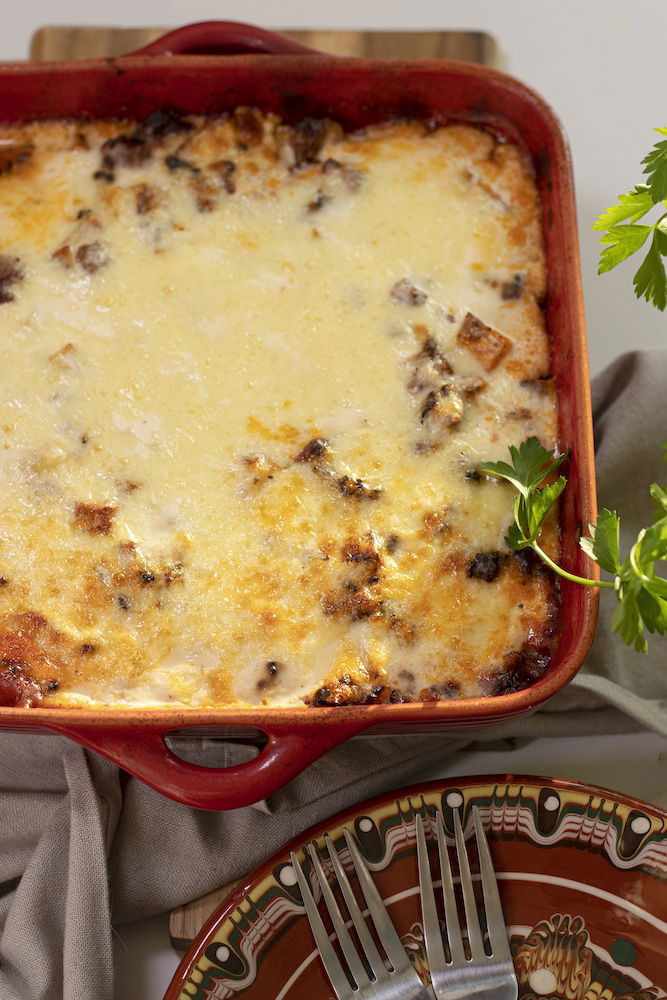
Yes, you recognize the name, and that’s because it’s the Bosnian version of the Greek Moussaka. Here, we have potato and minced beef cooked in a casserole, but in this case, there is no creamy sauce inside. Instead, the potato is arranged in layers, almost like a lasagne, with the beef in between. The top layer is usually sour cream or egg.
As you can probably tell by now, many of the dishes in this Bosnian food guide are popular throughout the Balkans. Musaka is no exception. It’s a ground beef and potato casserole popular in the cuisines of Bosnia and Herzegovina, Serbia, Croatia, and North Macedonia. You can think of it as the Balkan equivalent of moussaka.
Bosnian Vegetarian Dishes
17. Tarhana

Tarhana corbasi is a soup with Turkish origins found in different variations in the rest of the Balkans, Greece, and Cyprus.
Regarding tarhana, ingredients vary from country to country; however, its base usually includes flour and wheat, yogurt, and sour milk.
In Bosnia, the soup is made with a mixture of fermented milk (which gives it a characteristic sour flavor), yogurt, wheat, and vegetables; sometimes, it has meat.
Tarhana is perfect for winter and is served any time of the day, even as a snack or during breakfast.
18. Bosnian Bean Soup: Grah
One more soup belonging to Bosnian gastronomy is this tasty, thick soup made with vegetables, including onions, peppers, carrots, some slow-cooked beef, and, of course, the main ingredient: Peruano beans.
The dish, which is very traditional Bosnian cuisine and highly consumed, especially in winter, is often served with rice or bread. It is an excellent weapon against frigid temperatures.
19. Buranija
This is a type of bean that is often added to many dishes but can be eaten alone. It’s used in a goulash and often accompanied with meat, veal, but it can be vegetarian, too, with potatoes, garlic, and other vegetables. You’ll usually see it seasoned with bay leaves and paprika, and any meat is cooked for many hours so it melts in your mouth.
20. Đuveč
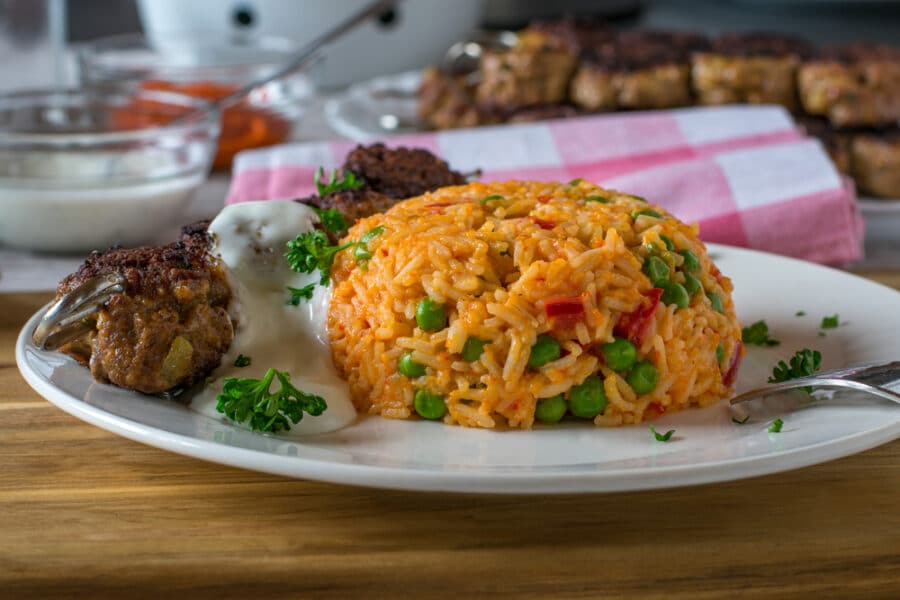
As in many other countries in Eastern Europe, the Balkans, and even Greece, rice is much more eaten than you would have expected. In general, dishes have a strong vegetarian component, and there are a lot of dishes without meat. Djuvec is one of them.
Cooked in a typical round pot bearing the same name as the dish, Djuvec is a vegetarian dish made with various seasonal vegetables and rice. Everything is slow-cooked for at least 2 hours in this pot and well-seasoned. When the dish is ready, it can be served alone as a main dish or the perfect side dish for a succulent piece of grilled or stewed beef.
21. Prebranac
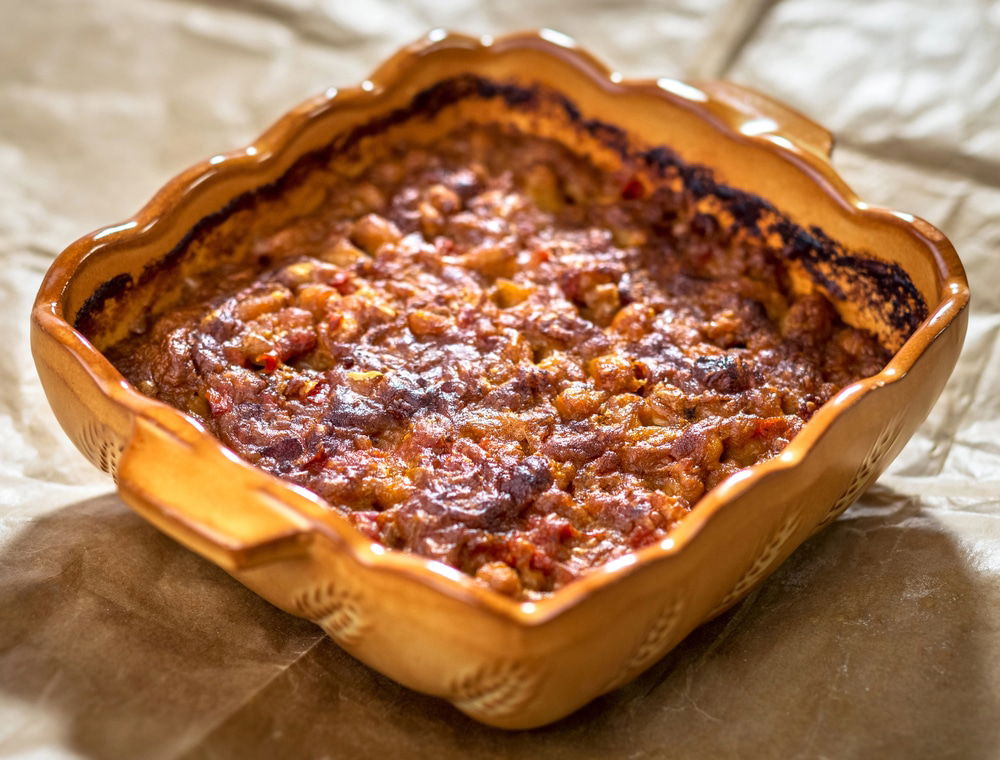
Prebranac is another stew-type dish made with white beans, paprika, garlic, and caramelized onions. Every restaurant and family makes it very slightly differently, but the base ingredients are basically the same.
It can be made with or without meat, but usually without. It’s then allowed to cool to room temperature, and you grab some bread and scoop it up.
22. Sataras
Following the tradition of seasonal veggies, sataras is another must-try Bosnian food. This genuinely beloved dish is popular in the Balkans, especially Sarajevo; it’s a healthy and delicious vegetarian dish.
The vegetables can be tomatoes, onions, bell peppers, potatoes, and even aubergines. As is the norm with Bosnian dishes, they are slow-cooked and suitable for vegetarians to eat alone or with plain white rice. They also make a fantastic side dish for a meat dish.
Bosnian Pastry & Desserts
We’ve mentioned several dishes in the savory list, so now we present you with some unique desserts you can try in Bosnia.
23. Ustipci

These small dough pieces are filled with a sweet or savory filling and then deep-fried. And, of course, they are among the most favorite snacks in the country.
Sweet ustipci are filled with various jams or even honey (modern versions can even have Nutella in them) and sprinkled with icing sugar on top. The savory ones can have cheese, onions, or meat inside.
In their sweet or savory version, ustipci is a Bosnian snack with very old origins, a traditional recipe passed from one generation to the next. It is common to have them with your coffee or salep tea.
24. Baklava
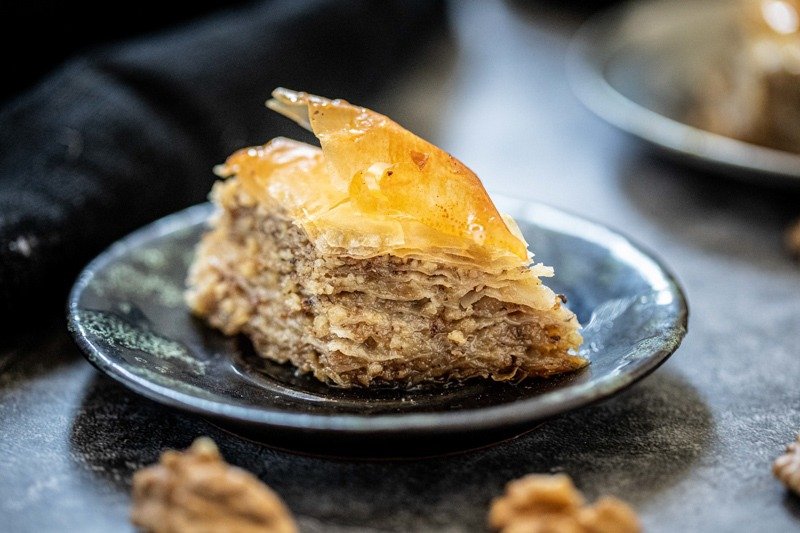
Baklava is a sweet dessert popular in the Middle East, Greece, some Northern African countries, and Turkey. Bosnian desserts are sweet, and this one is no exception.
Baklava features dozens of thin phyllo pastry sheets stuck together with olive oil or melted butter, filled with crushed nuts (sometimes even pistachio), and drizzled with syrup made with honey.
It is sweet and perfect when this flaky pastry is served with a cup of coffee, tea, or even a scoop of whipped cream.
25. Tufahija
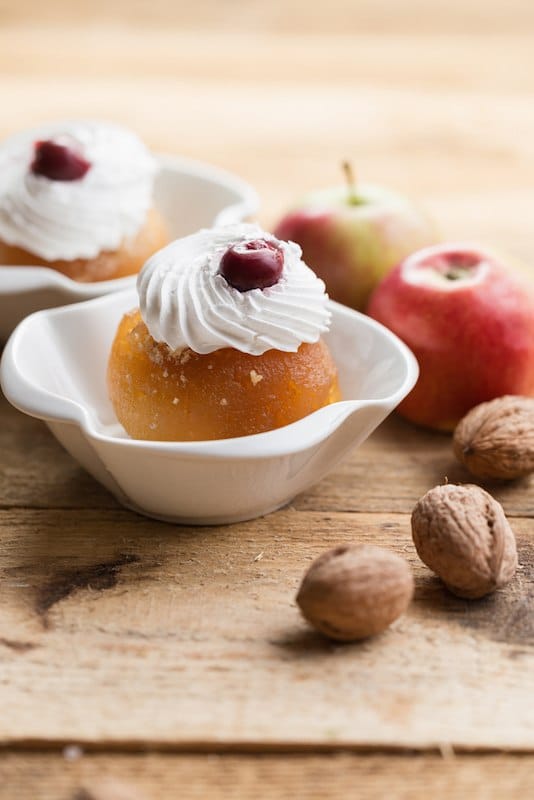
Another very sweet dessert with Ottoman origins is tufahija; this recipe takes a simple ingredient like apples and turns them into an authentic delicacy.
To cook this dish, apples are cored and boiled in water with sugar and then served topped with walnuts and whipped cream; it is also common to drizzle it with warm cooking juice (which has turned into a thick, savory syrup). Perfect to have it with a cup of Bosnian coffee.
26. Hurmasice

Hurmasice is a fantastic (yet straightforward) Bosnian food – it is a baked shortbread cookie made with butter, flour, eggs, sugar, and yogurt.
They have an oblong shape and are drenched in a lemon-scented, very sweet syrup as soon as they come out of the oven. It is incredibly delicious, perfect for a cup of Bosnian coffee.
27. Krofne
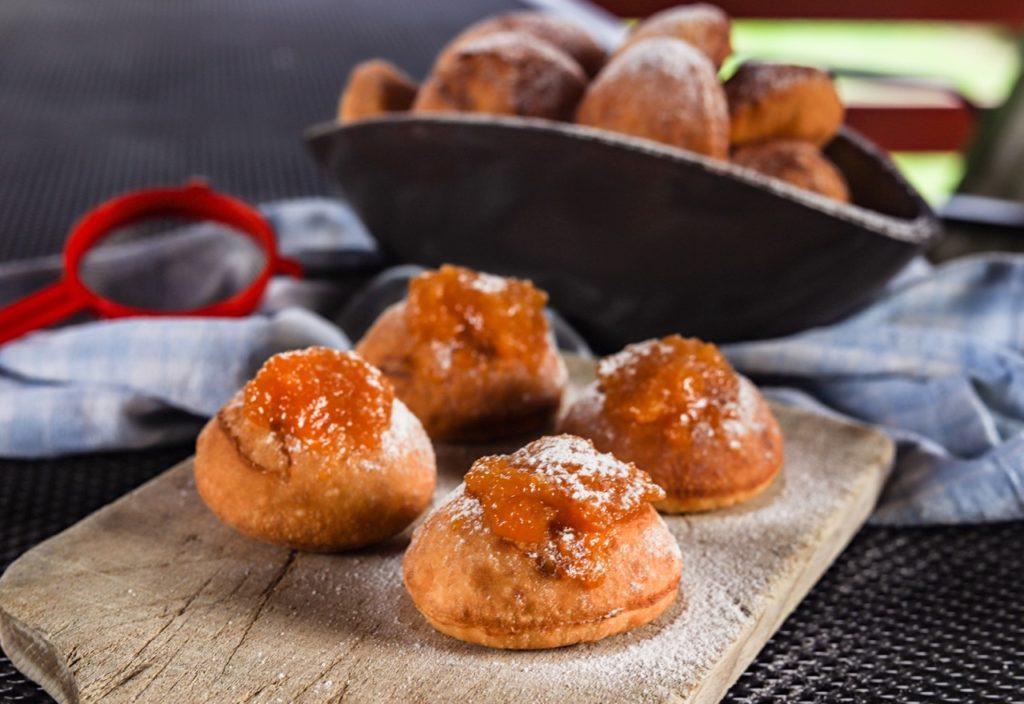
This is another type of doughnut that is very popular all over the Balkans. They look a bit like beignets in appearance, and they’re often filled with cinnamon, jam, Nutella, or marmalade.
28. Knedle
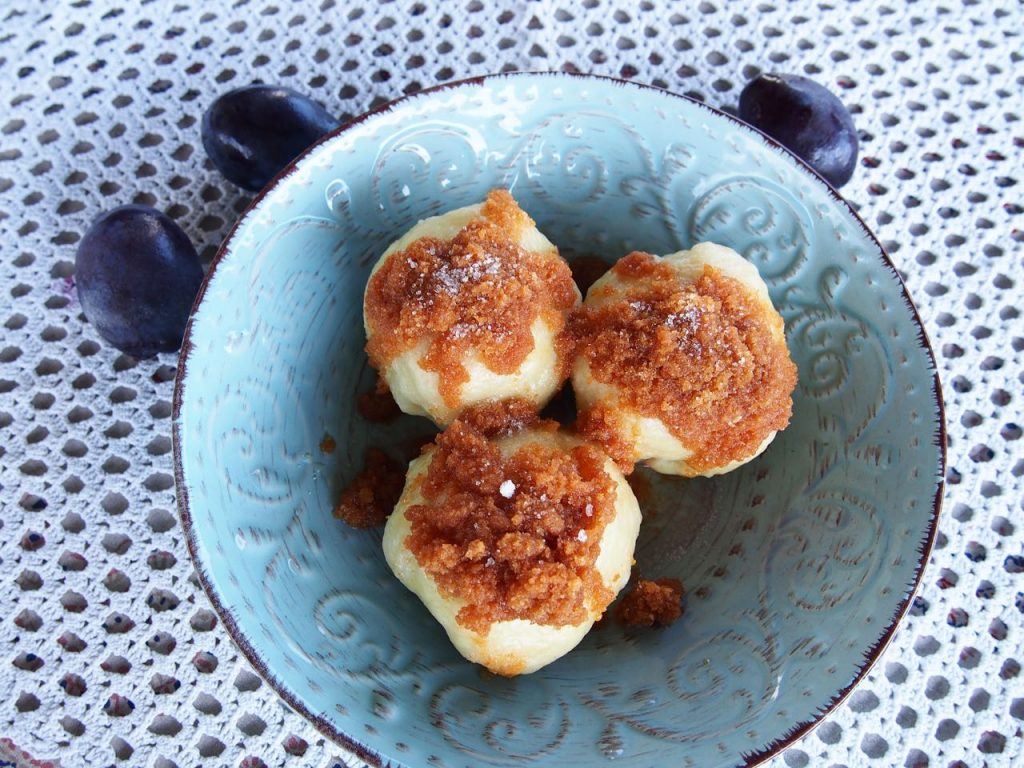
Knedle is a dessert made from potatoes, of all things. The outside is boiled potato, but it’s then filled with fruits, usually apricots or plums, a little like a dumpling. It is then sprinkled with sugar or sometimes cinnamon and then breadcrumbed and fried.
Move This Adventure To Your Inbox & Get An Instant Freebie

No spam. Unsubscribe at any time.
Bosnian Drinks
29. Bosnian Coffee

Bosnian coffee is an integral part of the local cuisine. It is often strong and drank black. It is often served in tiny cups with a traditional sugar cube on the side or a small sweet, especially in a cafeteria.
Although it might look similar to Turkish coffee, avoid calling it that way when in Bosnia; prefer to call it Bosanska kahva to avoid offending the locals.
30. Beer
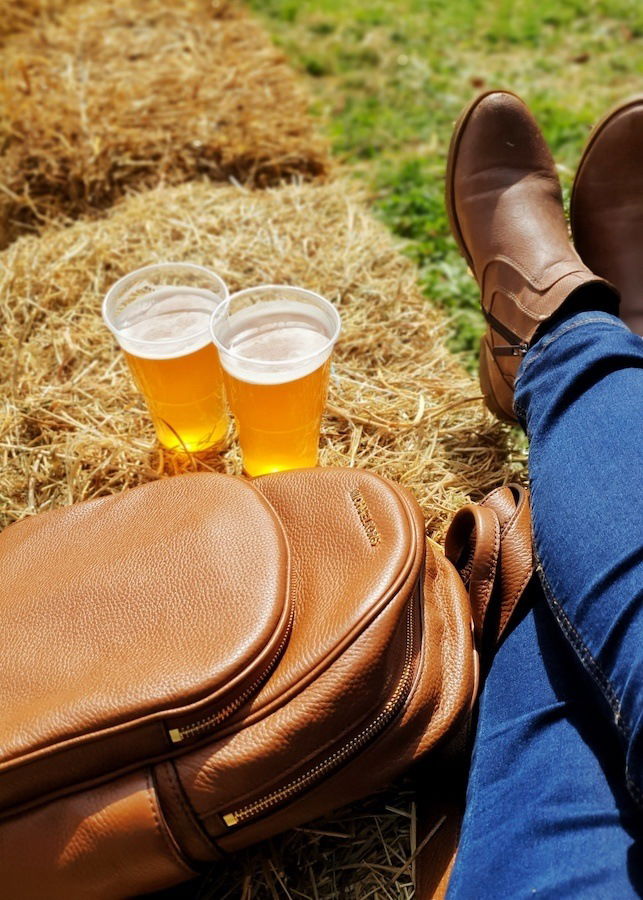
You won’t only drink coffee in Bosnia, that is for sure!
It is also a good idea to try the local beers, known as pivo, which is one of the many meat dishes we discussed earlier in the article. The most popular ones include Republika Srpska’s Nektar and Hercegovacka Pivovara.
31. Rakija

Another drink you will undoubtedly come across is Rakija, a popular kind of grappa or liquor that can be made with different types of fruits, drank not just in Bosnia but in many other countries around the Balkans. It has a high alcohol volume and should be served ice-cold.
32. Salep
Finally, do not miss a drink that is undoubtedly lesser-known but has a unique flavor that you won’t easily forget. Salep, with its Ottoman origins, is a very popular winter drink in Turkey and Bosnia, where it is often described as salep tea.
Salep is, in fact, not just the name of the drink but also made of the particular kind of flour used to prepare this comforting hot drink. The flour is made from the tuber of certain orchid flowers. It is often served with sweet spices, such as cinnamon, some sugar, and usually hot foamy milk.
So, tell us which of these Bosnian foods you want to try first.


Wedding Venues in kapashera List of Farmhouses , Banquet Halls, Hotels for Party places in kapashera and NH-8 and Pushpanjali Ever thought of enjoying a multi-theme Wedding Function while being at just one destination? If not then you must not have visited kapashera NH-8 & Pushpanjali Farmhouses.
nice